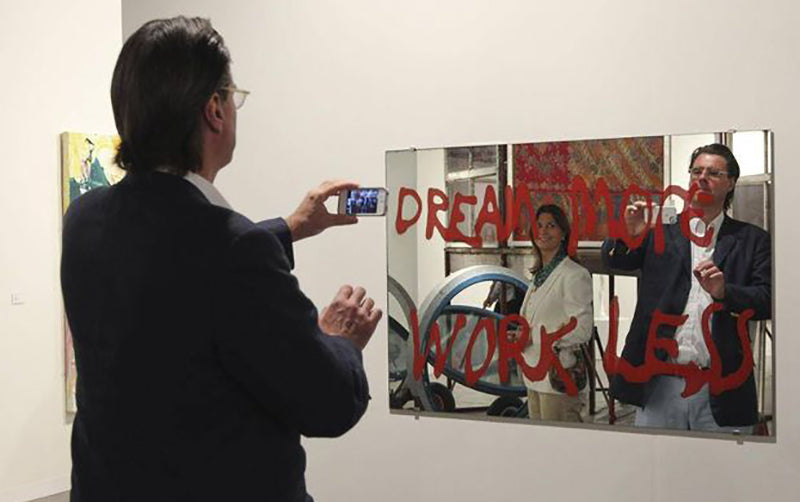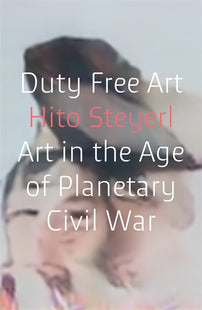"Is Art a Currency?" | Hito Steyerl
In this excerpt from Duty Free Art, Hito Steyerl questions the emerging role of contemporary art as currency in the age of planetary civil war: an era marked by rising inequality and rapid technological change.

Is art a currency? Investor Stefan Simchowitz thinks so. He wrote with uncompromising clarity about the post-Brexit era: “Art will effectively continue its structural function as an alternative currency that hedges against inflation and currency depreciation.” Have silver paintings become a proxy gold standard? How did it come to this? During the ongoing crisis, investors were showered with tax money, which then went into freeport collections, tower mansions, and shell companies. Quantitative easing eroded currency stability and depleted common resources, entrenching a precarious service economy with dismal wages, if any, eternal gigs, eternal debt, permanent doubt, and now increasing violence. This destabilization is one reason the value of art looks more stable than the prospects of many national GDPs. In the EU this takes place against a backdrop of mass evictions, austerity, arson attacks, Daesh run amok, and Deutsche Bank scams. Results include child poverty, debt blackmail, rigged economies, and the fascist scapegoating of others for widely self-inflicted failed policies. Art is an “alternative currency” of this historical moment. It seems to trade against a lot of misery.
Meanwhile, reactionary extremism intensifies in many places. I won’t bore you with specifics. There’s always another attack, election, coup, or someone who ups the ante in terms of violence, misogyny, snuff, or infamy. Derivative fascisms continue to grow, wherever disenfranchised middle classes fear (and face) global competition—and choose to both punch down and suck up to reactionary oligarchies. Ever more self-tribalized formations pop up that prefer not to abolish neoliberal competition—but instead eliminate competitors personally. Derivative fascisms try to fuse all-out free trade economics with, for example, white nationalism or an extreme conservative religious group identity, by promoting survival of the fittest for everyone except themselves. Authoritarian neo- liberalism segues into plain authoritarianism.
A permanent fog of war is fanned by permanent fakes on Facebook. Already deregulated ideas of truth are destabilized even further. Emergency rules. Critique is a troll fest. Crisis commodified as entertainment. The age of neoliberal globalization seems exhausted and a period of contraction, fragmentation, and autocratic rule has set in.
Alternative Currency
Art markets seem not overly concerned. In times in which financial institutions and even whole political entities may just dissolve into fluffy glitter, investment in art seems somehow more real. Moreover, as an alternative currency, art seems to fulfill what ether and bitcoin have hitherto only promised. Rather than money issued by a nation and administrated by central banks, art is a networked, decentralized, widespread system of value. It gains stability because it calibrates credit or disgrace across competing institutions or cliques. There are markets, collectors, museums, publications, and the academy asynchronously registering (or mostly failing to do so) exhibitions, scandals, likes, and prices. As with cryptocurrencies, there is no central institution to guarantee value; instead there is a jumble of sponsors, censors, bloggers, developers, producers, hipsters, handlers, patrons, privateers, collectors, and way more confusing characters. Value arises from gossip-cum-spin and insider information. Fraudsters and con artists mix helter-skelter with pontificating professors, anxious gallerists, and couch-surfing students. This informal ecology is eminently hackable, but since everyone does it, it sometimes evens out—even though at highly manipulated levels. It is at once highly malleable and inert, sublime, dopey, opaque, bizarre, and blatant: a game in which the most transcendental phenomena are on collectors’ waiting lists. Further down the line, media art, like bitcoin, tries to manage the contradictions of digital scarcity by limiting the illimitable. But for all its pretense to technological infallibility, bitcoin is potentially just as dependent on group power as art-market values are dependent on consent, collusion, and coincidence. What looks like incorruptible tech in practice hinges on people’s actions. As to the encryption part in art: art is often encrypted to the point of sometimes being undecryptable. Encryption is routinely applied, even or especially if there is no meaning whatsoever. Art is encryption as such, regardless of the existence of a message with a multitude of conflicting and often useless keys. Its reputational economy is randomly quantified, ranked by bullshit algorithms that convert artists and academics into ranked positions, but it also includes more traditionally clannish social hierarchies. It is a fully ridiculous, crooked, and toothless congregation and yet, like civilization as a whole, art would be a great idea.
In practice though, art industries trigger trickle-up effects which are then flushed sideways into tax havens. Art’s economies divert investments from sustainable job creation, education, and research and externalize social cost and risk. They bleach neighborhoods, underpay, overrate, and peddle excruciating baloney.
This applies not only to art’s investor and manager classes. The lifestyles of many art workers also support a corporate technological (and antisocial) infrastructure that whisks off profits into fiscal banana republics. Apple, Google, Uber, Airbnb, Ryanair, Facebook, and other hipster providers pay hardly any taxes in Ireland, Jersey, or other semisecret jurisdictions. They don’t contribute to local services like schools or hospitals and their idea of sharing is to make sure they get their share.
But let’s face it—in relation to the scale of other industries, the art sector is just a blip. Contemporary art is just a hash for all that’s opaque, unintelligible, and unfair, for top-down class war and all-out inequality. It’s the tip of an iceberg acting as a spear.
Degenerate Art
Predictably, this leads to resentment and outright anger. Art is increasingly labeled as a decadent, rootless, out-of-touch, cosmopolitan urban elite activity. In one sense, this is a perfectly honest and partly pertinent description. Contemporary art belongs to a time in which everything goes and nothing goes anywhere, a time of stagnant escalation, of serial novelty as deadlock. Many are itching for major changes, some because the system is pointless, harmful, 1 percentish, and exclusive, and many more because they finally want in.
On the other hand, talk of “rootless cosmopolitans” is clearly reminiscent of both Nazi and Stalinist propaganda, who relished in branding dissenting intellectuals as “parasites” within “healthy national bodies.” In both regimes this kind of jargon was used to get rid of minority intelligentsias, formal experiments, and progressive agendas; not to improve access for locals or improve or broaden the appeal of art. The “anti-elitist” discourse in culture is at present mainly deployed by conservative elites, who hope to deflect attention from their own economic privileges by relaunching stereotypes of “degenerate art.”
So if you are hoping for new opportunities with the authoritarians, you might find yourself disappointed.
Authoritarian right-wing regimes will not get rid of art-fair VIP lists or make art more relevant or accessible to different groups of people. In no way will they abolish elites or even art. They will only accelerate inequalities, beyond the fiscal-material to the existential-material. This transformation is not about accountability, criteria, access, or transparency. It will not prevent tax fraud, doctored markets, the Daesh antiquities trade, or systemic underpay. It will be more of the same, just much worse: less pay for workers, less exchange, fewer perspectives, less circulation, and even less regulation, if such a thing is even possible. Inconvenient art will fly out the window—anything non-flat, non-huge, or remotely complex or challenging. Intellectual perspectives, expanded canons, nontraditional histories will be axed—anything that requires an investment of time and effort instead of conspicuous money. Public support swapped for Instagram metrics. Art fully floated on some kind of Arsedaq. More fairs, longer yachts for more violent assholes, oil paintings of booty blondes, abstract stock-chart calligraphy. Yummy organic superfoods. Accelerationist designer breeding. Personalized one-on-one performances for tax evaders. Male masters, more male masters, and repeat. Art will take its place next to big- game hunting, armed paragliding, and adventure slumming.
Yay for expensive craft and anything vacuous that works in a chain-hotel lobby. Plastiglomerate marble, welded by corporate characters banging on about natural selection. Kits for biological “self-improvement.” Crapstraction, algostraction, personalized installations incorporating Krav Maga lessons. Religious nailpaint will slay in all seasons, especially with a Louis Vuitton logo. Hedge-fund mandalas. Modest fashion. Immodest fashion. Nativist mumbo jumbo. Genetically engineered caviar in well-behaved ethnic pottery. Conceptual plastic surgery. Racial plastic surgery. Bespoke ivory gun handles. Murals on border walls. Good luck with this. You will be my mortal enemy.
Just like institutional critique was overtaken by a neoliberal Right that went ahead and simply abolished art institutions, the critique of contemporary art and claims for an exit from this paradigm are dwarfed by their reactionary counterparts. The reactionary exit—the acceleration of stagnation—is already well underway. Algorithmic and analogue market manipulation, alongside the defunding, dismantling, and hollowing-out of the public and post-public sector, transforms what sometimes worked as a forum for shared ideas, judgment, and experimentation into HNWI interior design. Art will be firewalled within isolationist unlinked canons, which can easily be marketed as national, religious, and fully biased histories.
Duty Free Art is now 40% off until Sunday! Offer ends April 7, 23.59 GMT.
[book-strip index="1" style="buy"]
